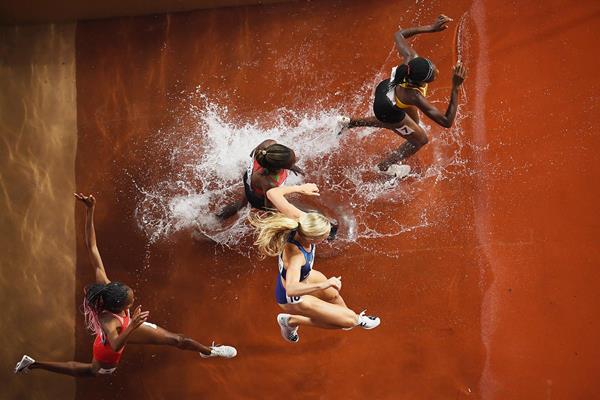This is the only distance event on the programme in which athletes negotiate barriers.
Athletes cover a distance of 3000m, but the precise number of laps depends on the position of the water jump and whether it is placed on the inside or the outside of the track’s second bend. Athletes make a bunched standing start and can break immediately for the inside.
Competitors must always clear 28 fixed barriers and seven water jumps during the duration of the race. The finishing order is determined on time.
At major championships, the 3000m steeplechase format typically consists of heats (sometimes semi-finals) and final.
The men’s barriers are 36in (91.4cm) high, the women’s 30in (76.2cm). The water jump’s landing area is 12ft (3.66m) long and 70cm at its deepest.
Besides strength endurance and an impressive aerobic capacity, top steeplechasers also require good agility.

This event has its origins in Britain; runners would race from one town’s steeple to the next, jumping obstacles such as streams and low walls. The current event can be traced to the two-mile steeplechases run at Oxford University in the mid-19th century. It was made a track event, with barriers, at the 1879 English Championships.
The current format has been contested by men – initially over varying distances – at every Olympic Games since 1900. The women’s event was introduced as recently as 2008.
Perhaps no nation dominates any event quite like Kenya does the steeplechase. Since Amos Biwott struck gold at the 1968 Olympic Games, Kenya has won every men’s Olympic steeplechase title up to and including 2016 with the exception of two. In the women’s steeplechase, Russia, Tunisia and Bahrain won the 2008, 2012 and 2016 Olympic titles respectively.
 MAR
MAR
 ETH
ETH
 KEN
KEN
 KEN
KEN
 ETH
ETH
 ETH
ETH
 KEN
KEN
 JPN
JPN
 NZL
NZL
 ETH
ETH
 BRN
BRN
 KEN
KEN
 KEN
KEN
 KEN
KEN
 ETH
ETH
 ETH
ETH
 ALB
ALB
 SLO
SLO
 FRA
FRA
 UGA
UGA







